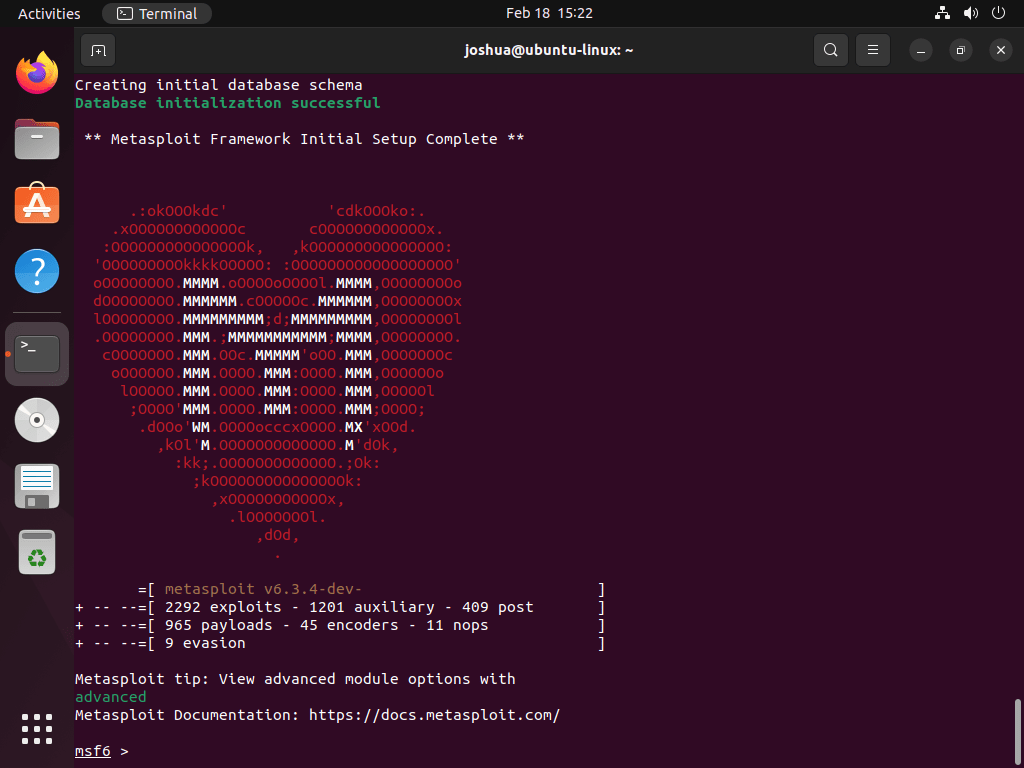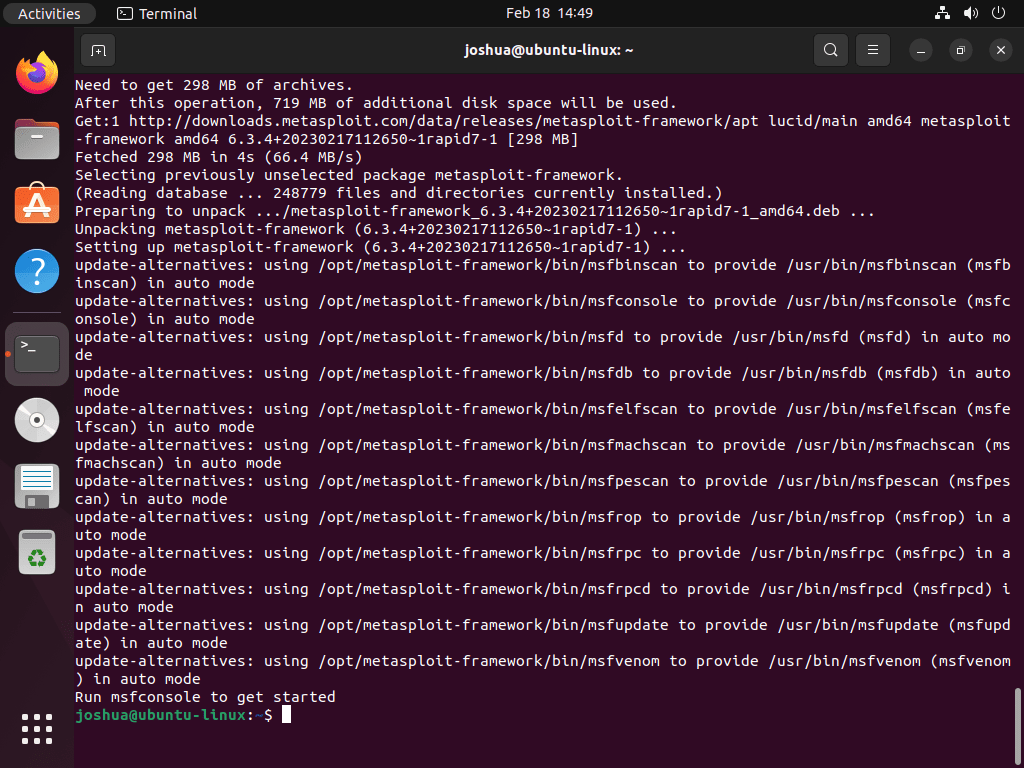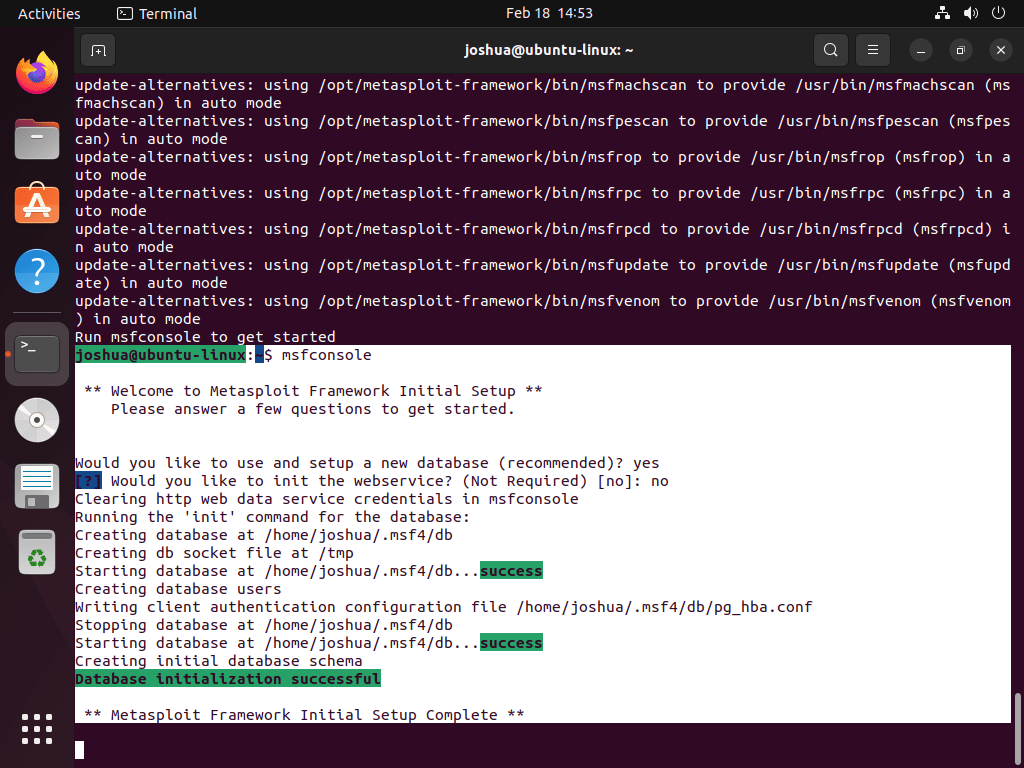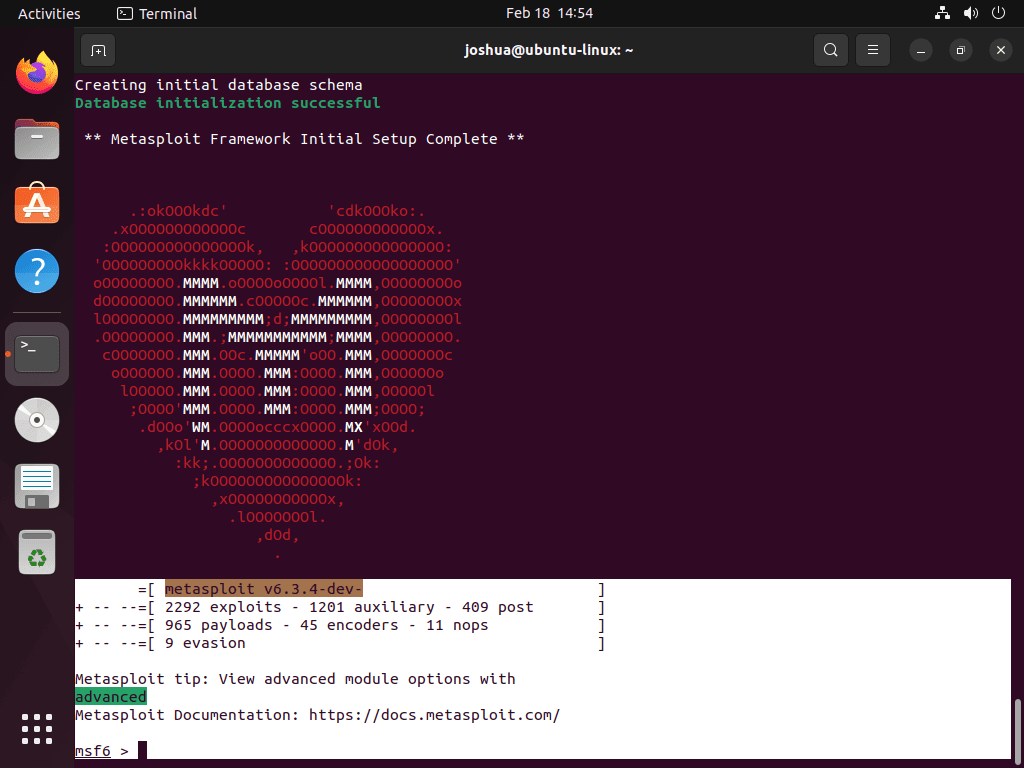Metasploit Framework is an open-source platform that has become a powerful tool for penetration testing and vulnerability assessment in today’s cybersecurity landscape. It is designed to help security professionals perform comprehensive testing of their network’s security posture, identify potential weaknesses, and mitigate them before attackers can exploit them.
If you are in the field of information security or work in a related area, installing Metasploit Framework on your system can offer several benefits, including:
- Robust Exploitation Capabilities: With over 1,500 exploits, Metasploit Framework provides a vast library of exploits that can test various operating systems, applications, and devices. It allows you to conduct automated attacks to pinpoint system vulnerabilities, test patch effectiveness, and provide detailed reports.
- Flexible Payload Options: Payloads are used to deliver a malicious payload to a victim’s system. Metasploit Framework offers a wide range of payloads that can be customized for different scenarios. Payload options include reverse shell, meterpreter, and VNC, among others.
- Multiple Interfaces: Metasploit Framework supports multiple interfaces, making it easy for users to choose the most comfortable environment to work in. The web interface is the most user-friendly and can be accessed from any device with a web browser.
- Collaborative Environment: Metasploit Framework provides a collaborative platform where users can share their exploits, payloads, and modules. This encourages collaboration among security professionals, enhances knowledge sharing, and ensures everyone stays updated with the latest vulnerabilities and mitigation strategies.
- Scripting Support: The framework allows creating custom scripts to automate tasks and workflows, making it an ideal choice for complex and time-consuming processes.
However, installing Metasploit Framework on your main computer production environment should be done cautiously. Some of the risks to consider include the following:
- Metasploit is a powerful tool that can cause serious damage if used incorrectly, especially in a production environment. An accidental click of the wrong button can result in a system becoming unstable, resulting in loss of data, loss of productivity, and in extreme cases, lawsuits.
- The framework is also often used by cybercriminals to launch attacks. Installing Metasploit in a production environment with no protective measures can create more security risks than benefits.
Now that we have introduced the topic, this guide will explain the process of installing the Metasploit Framework on a Ubuntu 22.04 Jammy Jellyfish or Ubuntu 20.04 Focal Fossa system through the command line terminal. Additionally, it will provide step-by-step instructions for setting up the graphical interface for the first time.
Step 1: Install Dependencies
Update and Upgrade Ubuntu
Before installing the dependencies, we need to update and upgrade the Ubuntu system. Run the following commands in your terminal:
sudo apt update
sudo apt upgradeInstall Dependencies
Once the system is updated, we can now install the required dependencies. Run the following command to install all the necessary packages:
sudo apt install curl ca-certificates apt-transport-https software-properties-common lsb-release postgresql -yStep 2: Import Metasploit Repository
Once you have installed the necessary dependencies, importing the Metasploit repository is next. To ensure that the packages in the repository are genuine and have not been tampered with, you must import the GPG key associated with the repository. This key will be used to verify the authenticity of the packages during installation.
curl -fsSL https://apt.metasploit.com/metasploit-framework.gpg.key | sudo gpg --dearmor | sudo tee /usr/share/keyrings/metasploit.gpg > /dev/nullNow that you have imported the GPG key, you can import the Metasploit repository by executing the following command in your terminal or command prompt.
echo "deb [signed-by=/usr/share/keyrings/metasploit.gpg] http://downloads.metasploit.com/data/releases/metasploit-framework/apt lucid main" | sudo tee /etc/apt/sources.list.d/metasploit.list
Step 3: Install Metasploit
After importing the GPG key and repository, refresh your APT cache. This will update your system’s package list and ensure the latest Metasploit Framework version is available for installation.
sudo apt updateTo install the Metasploit framework, execute the following command in your terminal or command prompt. This command will initiate the installation process for the framework and configure it to work on your system.
sudo apt install metasploit-frameworkAfter installing the Metasploit Framework, you must complete the first-time setup process. This involves following a series of prompts in your terminal to configure and prepare the framework for use.
In your terminal output, you should see “Run msfconsole to get started.”
msfconsoleExample:
During the first-time setup process for the Metasploit Framework, you may encounter various prompts depending on the specific version you are installing. Here is an example of some of the prompts you may encounter:
Setting up a new database: During the setup process, you may be prompted to set up a new database for the Metasploit Framework. Setting up a new database is recommended, and you can do so by typing “yes” when prompted.
Would you like to use and setup a new database (recommended)? Initializing the web service: You may be prompted to initialize the web service during setup. This is not required, and the default response is “no.” However, if you want to enable the web service, type “yes” when prompted.
[?] Would you like to init the webservice? (Not Required) [no]: Final configurations: After you have completed the prompts, you will need to wait for a minute or two while the final configurations are taking place. You may see a terminal screen that provides information on the configuration process, and it may be similar to the following:
Once you have completed the first-time setup process, you will be ready to use the Metasploit Framework.
Metasploit Framework Terminal Commands
In this section, the guide delves into the practical applications of using Metasploit Framework terminal commands to perform various tasks in different scenarios. A comprehensive table overview of all available commands will be provided at the end of this section.
Starting Metasploit Framework
To start Metasploit Framework, open a terminal window and enter the following command:
sudo msfconsoleThis will start with Metasploit Framework, and you will see a banner with information about the version, the contributors, and some tips on how to use Metasploit Framework.
Updating Metasploit Framework
Metasploit Framework is constantly updated with new modules, features, and bug fixes. To update Metasploit Framework, enter the following command in the terminal:
sudo msfupdateThis will update the Metasploit Framework to the latest version available.
Searching for Exploits
One of the main features of Metasploit Framework is the ability to search for exploits. To search for exploits, enter the following command in the terminal:
search <search-term>Replace <search-term> with a keyword or phrase related to the exploit you are looking for. For example, if you want to search for exploits related to the Apache Struts vulnerability, you can enter the following:
search strutsThis will display a list of all the available exploits related to the Apache Struts vulnerability.
Using Exploits
Once you have found an exploit that you want to use, you can use the following command to load the exploit module:
use <exploit-name>Replace <exploit-name> with the name of the exploit module. For example, if you want to use the Apache Struts exploit module, you can enter the following:
use exploit/windows/http/struts2_rest_xstreamThis will load the exploit module and display information about the module, such as the name, the author, the target platform, and the payload.
Configuring Exploit Options
Before running an exploit, you may need to configure some options, such as the target IP address, the target port, and the payload to use. You can view the options for an exploit by entering the following command:
show optionsThis will display a list of all the available options for the exploit module and their current values.
To set an option to a specific value, use the following command:
set <option-name> <value>Replace <option-name> with the name of the option and <value> with the value you want to set it to. For example, if you’re going to set the RHOST option to the IP address of the target system, you can enter the following:
set RHOST 192.168.1.100Running Exploits
Once you have configured the options for an exploit, you can run the exploit using the following command:
exploitThis will run the exploit and attempt to exploit the target system. If the exploit is successful, you will see a message indicating that the exploit has been completed and that you have a session.
Using Meterpreter
Meterpreter is a powerful post-exploitation tool that allows you to interact with the compromised system in real time. To use Meterpreter, you first need to have a session. To view the available sessions, enter the following command:
sessions -lThis will display a list of all available sessions and their ID numbers.
To interact with a specific session, use the following command:
sessions -i <session-id>Replace <session-id> with the ID number of the session you want to interact with. For example, if you’re going to interact with session 1, you can enter the following:
sessions -i 1This will start a Meterpreter shell for the selected session. From the Meterpreter shell, you can run various commands to perform actions on the compromised system.
Gathering System Information
One of the first things you may want to do when you have a Meterpreter session is to gather information about the compromised system. You can do this using the following commands:
sysinfoThis will display information about the system, such as the operating system version, the CPU type, and the system architecture.
getuid
This will display the current user ID on the system.
getprivsThis will display a list of the current user’s privileges on the system.
Uploading and Downloading Files
Meterpreter also allows you to upload and download files to and from the compromised system. To upload a file, use the following command:
upload <local-file> <remote-file>Replace <local-file> with the path to the local file you want to upload and <remote-file> with the path to the file on the compromised system.
For example, if you want to upload a file called passwords.txt to the C:\Temp directory on the compromised system, you can enter the following:
upload /path/to/passwords.txt C:\Temp\passwords.txtTo download a file from the compromised system, use the following command:
download <remote-file> <local-file>Replace <remote-file> with the path to the file on the compromised system and <local-file> with the path to the local file.
For example, if you want to download a file called passwords.txt from the C:\Temp directory on the compromised system to your local Downloads directory, you can enter the following:
download C:\Temp\passwords.txt /path/to/Downloads/passwords.txtUsing Metasploit to Exploit Known WordPress Vulnerabilities
WordPress is a widely used content management system (CMS) that powers millions of websites worldwide. Due to its widespread use, WordPress is a common target for hackers looking for potential vulnerabilities. However, with Metasploit, you can use its powerful tools to test your WordPress websites for any known vulnerabilities. It is important to remember that using Metasploit to exploit other websites or systems is illegal and unethical.
Now here’s an example of how to use Metasploit to exploit a known vulnerability in WordPress:
Use the search command to find modules related to WordPress vulnerabilities:
search type:exploit platform:php app:wordpressThis command will return a list of Metasploit modules that can be used to exploit vulnerabilities in WordPress.
Choose a module to use, and configure any necessary options. For example, to exploit the WordPress TimThumb plugin vulnerability, you can use the following module:
use exploit/multi/http/timthumb_file_uploadOnce you have selected the module, you can use the options command to configure any required options. For example, you may need to specify the target host and port and the path to the WordPress installation.
Run the exploit to exploit the vulnerability. For example, to run the TimThumb exploit, you can use the following command:
exploitThis will run the exploit and attempt to upload a shell to the target system.
Use the Meterpreter payload to gain access to the target system. If the exploit is successful, you can view any active Meterpreter sessions using the session command. You can then use the session command to connect to the session and gain access to the target system.
sessions
session 1Use the Meterpreter shell to gather information or perform actions on the target system. Once you have gained access to the target system, you can use the Meterpreter shell to perform various tasks. For example, you can use the upload command to upload files to the target system or the download command to download files from the target system.
upload /path/to/local/file /path/to/remote/file
download /path/to/remote/file /path/to/local/fileMetasploit Commands Table List
While this guide briefly demonstrates using Metasploit commands, it is important to note that the commands listed here represent only a tiny fraction of what can be achieved with the framework. The guide will present a table of the most commonly used commands to provide a more comprehensive overview.
Exploit Commands
Exploit commands are used to exploit vulnerabilities in a target system.
| Command | Description |
|---|---|
search | Search for a specific exploit or payload. |
use | Select an exploit or payload to use. |
show options | Show the current options for an exploit or payload. |
set | Set the value of an option. |
exploit | Execute the selected exploit. |
sessions | Manage Meterpreter sessions. |
back | Exit the current exploit or payload. |
Auxiliary Commands
Auxiliary commands perform various tasks such as scanning, fuzzing, and information gathering.
| Command | Description |
|---|---|
search | Search for a specific auxiliary module. |
use | Select an auxiliary module to use. |
show options | Show the current options for an auxiliary module. |
set | Set the value of an option. |
run | Execute the selected auxiliary module. |
back | Exit the current auxiliary module. |
Post-Exploitation Commands
Post-exploitation commands perform various tasks after gaining access to a system.
| Command | Description |
|---|---|
sysinfo | Display system information. |
getuid | Display the current user ID. |
getprivs | Display the current user’s privileges. |
shell | Drop into a system shell. |
ps | List running processes. |
migrate | Migrate to another process. |
download | Download a file from the target system. |
upload | Upload a file to the target system. |
Database Commands
Database commands are used to interact with the Metasploit Framework database.
| Command | Description |
|---|---|
db_status | Check the status of the database. |
db_rebuild_cache | Rebuild the cache. |
db_nmap | Import a nmap scan into the database. |
hosts | List all hosts in the database. |
services | List all services in the database. |
vulns | List all vulnerabilities in the database. |
Module Management Commands
Module management commands are used to manage modules in Metasploit Framework.
| Command | Description |
|---|---|
load | Load a module into the console. |
reload_all | Reload all modules. |
unload | Unload a module from the console. |
info | Display information about a module. |
edit | Edit a module. |
Conclusion
This guide has shown how to install Metasploit through the command line interface by importing the GPG key and repository with CLI commands, then installing Metasploit using the terminal and configuring the necessary steps. We have also explored some of the most commonly used Metasploit terminal commands, organized by their functions, such as searching for vulnerabilities, managing modules, interacting with the Metasploit Framework database, and performing various tasks after gaining access to a system.




